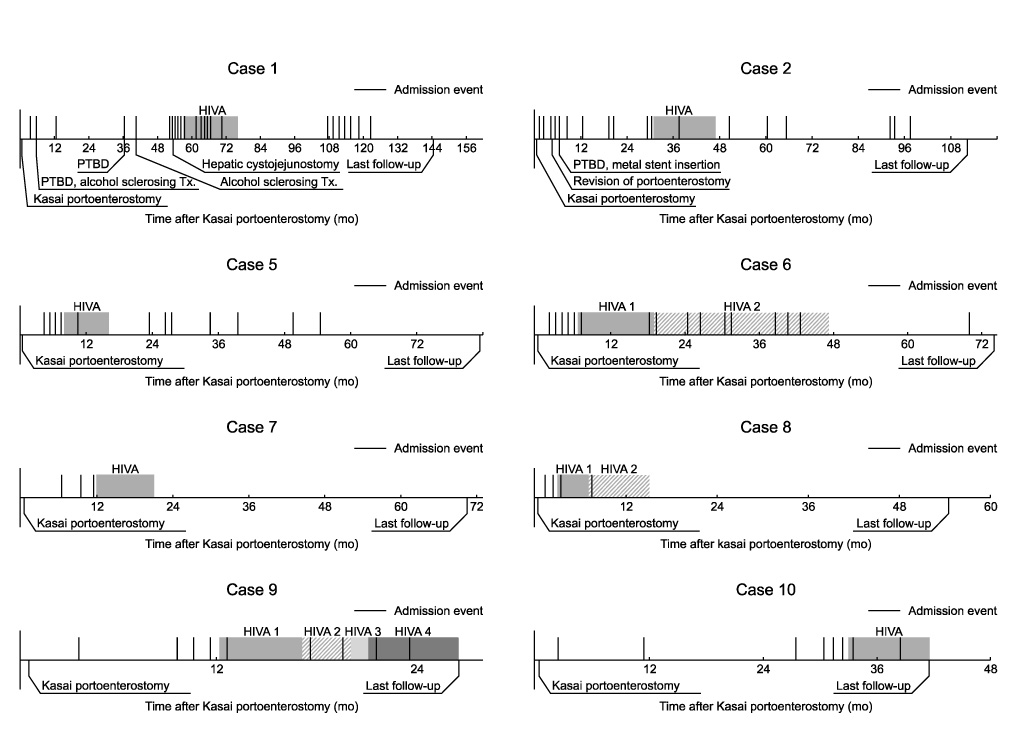J Korean Surg Soc.
2011 May;80(5):355-361. 10.4174/jkss.2011.80.5.355.
Home intravenous antibiotic treatment for intractable cholangitis in patients with biliary atresia following Kasai portoenterostomies
- Affiliations
-
- 1Division of Pediatric Surgery, Department of Surgery, Severance Children's Hospital, Yonsei University College of Medicine, Seoul, Korea. sjhan@yuhs.ac
- 2Department of Surgery, Yongin Severance Hospital, Yonsei University College of Medicine, Yongin, Korea.
- KMID: 2212161
- DOI: http://doi.org/10.4174/jkss.2011.80.5.355
Abstract
- PURPOSE
Patients with biliary atresia (BA) treated with Kasai portoenterostomy may later develop intractable cholangitis (IC) that is unresponsive to routine conservative treatment. It may cause biliary cirrhosis and eventually hepatic failure with portal hypertension. Control of IC requires prolonged hospitalization for the administration of intravenous antibiotics. To reduce the hospitalization period, we designed a home intravenous antibiotic treatment (HIVA) which can be administered after initial inpatient treatment. In this study, we reviewed the effects of this treatment.
METHODS
We reviewed medical records of 10 patients treated with HIVA for IC after successful Kasai portoenterostomies performed for BA between July 1997 and June 2009.
RESULTS
The duration of HIVA ranged from 8 to 39 months (median, 13.5 months). The median length of hospital stay was 5.7 days per month for conventional treatments to manage IC before HIVA and, 1.5 days per month (P = 0.012) after HIVA. The median amount of medical expenses per month was reduced by about one tenth with HIVA. One patient underwent liver transplantation due to uncontrolled esophageal variceal bleeding, but the other nine patients had acceptable hepatic function with native livers.
CONCLUSION
HIVA may be an effective primary treatment for IC after Kasai portoenterostomies for BA, and reduce length of hospital stay and medical expense.
MeSH Terms
Figure
Reference
-
1. Ecoffey C, Rothman E, Bernard O, Hadchouel M, Valayer J, Alagille D. Bacterial cholangitis after surgery for biliary atresia. J Pediatr. 1987. 111(6 Pt 1):824–829.2. Ernest van Heurn LW, Saing H, Tam PK. Cholangitis after hepatic portoenterostomy for biliary atresia: a multivariate analysis of risk factors. J Pediatr. 2003. 142:566–571.3. Luo Y, Zheng S. Current concept about postoperative cholangitis in biliary atresia. World J Pediatr. 2008. 4:14–19.4. Nakama T, Kitamura T, Matsui A, Makino S, Senyuz OF, Kanazawa K. Ultrasonographic findings and management of intrahepatic biliary tract abnormalities after portoenterostomy. J Pediatr Surg. 1991. 26:32–36.5. Tsuchida Y, Honna T, Kawarasaki H. Cystic dilatation of the intrahepatic biliary system in biliary atresia after hepatic portoenterostomy. J Pediatr Surg. 1994. 29:630–634.6. Takahashi A, Tsuchida Y, Suzuki N, Kuroiwa M, Ikeda H, Hirato J, et al. Incidence of intrahepatic biliary cysts in biliary atresia after hepatic portoenterostomy and associated histopathologic findings in the liver and porta hepatis at diagnosis. J Pediatr Surg. 1999. 34:1364–1368.7. Bu LN, Chen HL, Ni YH, Peng S, Jeng YM, Lai HS, et al. Multiple intrahepatic biliary cysts in children with biliary atresia. J Pediatr Surg. 2002. 37:1183–1187.8. Wu ET, Chen HL, Ni YH, Lee PI, Hsu HY, Lai HS, et al. Bacterial cholangitis in patients with biliary atresia: impact on short-term outcome. Pediatr Surg Int. 2001. 17:390–395.9. Kimura K, Hashimoto S, Nishijima E, Muraji T, Tsugawa C, Matsutmo Y. Percutaneous transhepatic cholangiodrainage after hepatic portoenterostomy for biliary atresia. J Pediatr Surg. 1980. 15:811–816.10. Altman RP, Anderson KD. Surgical management of intractable cholangitis following successful Kasai procedure. J Pediatr Surg. 1982. 17:894–900.11. Muraji T, Tsugawa C, Nishijima E, Satoh S, Takamizawa S, Ise K, et al. Surgical management for intractable cholangitis in biliary atresia. J Pediatr Surg. 2002. 37:1713–1715.12. Yamanaka J, Iimuro Y, Hirano T, Kosaka H, Fujimoto J. Successful liver resection for biliary atresia with intrahepatic biliary cysts after Kasai procedure. J Pediatr Surg. 2005. 40:E9–E11.
- Full Text Links
- Actions
-
Cited
- CITED
-
- Close
- Share
- Similar articles
-
- Surgical treatment for intractable cholangitis with intrahepatic biliary cysts followed by Kasai operation in biliary atresia: a retrospective cohort study
- Therapeutic Efficacy of Cefotaxime as an Empirical Antibiotic on Ascending Cholangitis after Kasai Operation for Biliary Atresia
- Biliary Atresia
- Outcome of Patients Undergoing Kasai Procedure for Biliary Atresia: a Study of Those Surviving More Than 10 Years with Their Native Livers
- Overview of Biliary Atresia




